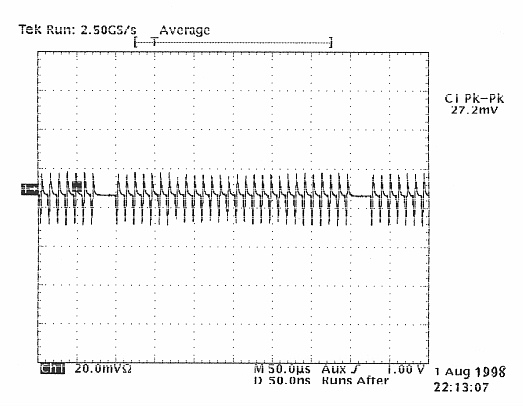
The main milestones of the DAFNE complex are summarized in the following Table. Details of the single achievements can be found under "Special Achievements"
| First electron beam accelerated by the Linac (700 MeV, 500 mA) | 30 November 95 |
| Accumulator installation completed | December 95 |
| Main Ring RF cavity powered to Specification | 3 April 96 |
| First electron beam at the end of Linac->Accumulator Transfer Line | 27 May 96 |
| First electron beam revolution in the Accumulator | 1 June 96 |
| First electron beam injected without RF in the Accumulator | 7 June 96 |
| First electron beam stored in the Accumulator | 21 June 96 |
| First positron beam accelerated by the Linac (435 MeV, 4 mA) | 12 July 96 |
| 120 mA stable single bunch beam in the Accumulator | 30 January 97 |
| Positron beam to Specification (525 MeV, 20 mA) from the Linac | 23 February 97 |
| Main Ring installation completed with chamber under vacuum | 7 September 97 |
| First electron beam extracted from the Accumulator | 20 September 97 |
| First electron beam injected into the electron Main Ring | 28 September 97 |
| First electron beam stored into the electron Main Ring | 25 October 97 |
| First positron beam injected and extracted from the Accumulator | 19 November 97 |
| First positron beam stored into the positron Main Ring | 22 November 97 |
| Design single bunch positron current (> 40 mA) reached in the Main Ring | 28 November97 |
| Design positron performance exceeded by the Linac (510 MeV, 59 mA, dE/E<±1.5%) | 13 February 98 |
| First electron-positron interactions detected by the luminosity monitor | 1 March 98 |
| 1030 cm-2s-1 single bunch luminosity exceeded | 31 October 98 |
| First two beam multibunch operation | 13 November 98 |
| First beam stored in DAFNE with KLOE on | 28 March 99 |
| Compensation of KLOE solenoid achieved | 1 April 99 |
| First beam-beam interactions in KLOE | 14 April 99 |
Two beams commissioning
A single bunch luminosity of 1.5*1030 cm-2s-1, to be compared with the design luminosity of 4x1030 cm-2s-1, has been exceeded in the "day-one" commissioning lattice. Multibunch operation has also been started in this configuration: 13 bunches have been stored in each beam up to a maximum current of 200 mA per beam. Luminosity in the range of 1031 cm-2s-1 has been measured.
After the long shut-down for the installation of the KLOE detector, two beam operation has been resumed at the end of March with the superconducting solenoid, the two compensators and the two permanent magnet quadrupole triplets on the KLOE interaction region; the DEAR experiment is also installed in the second crossing point, with electromagnetic quadrupole triplets. The first large angle scattering events have been observed by KLOE, with the beams separated in DEAR. The observed rate of Bhabha scattering confirms the luminosity measurements of the machine monitor.
About two weeks in April have been spent in tuning the energy of the beams to find the peak of the Phi resonance, in collaboration with the KLOE experiment. During this period the collider has been operated in single bunch configuration with initial luminosity of 3-4*1029 cm-2s-1 under stable and repeatable conditions.
Single beam commissioning
The maximum current in the single bunch mode has reached 110 mA for both positrons and electrons without any active feedback. The head-tail threshold without sextupoles is 10 mA. The design current in each bunch for two beams operation is 44 mA.
In the multibunch mode (all 120 buckets filled) 0.30 A in the positron beam and 0.23 A in the electron one have been stored without feedback.
The full month of July has been dedicated to high current multibunch operation and optimization of the ring lattice on the new working point at Qx ~5.11, Qy ~5.07. The longitudinal multibunch feedback systems have been tuned up with the beam: up to 0.55 A have been stored in 25 electron bunches with the spacing of four RF buckets and an ion clearing gap of 5 consecutive bunches. With the positron beam, 0.47 A have been stored in 28/30 equispaced bunches. The uniformity of the stored current among different bunches is quite satisfactory for both beams. The behaviour of both rings on the new working point is now well under control.
All these results have been obtained with the "day-one" commissioning lattice.

Typical positron fill (30 bunches). The gap of two missing bunches separates two successive revolutions.
After the installation of KLOE, both beams have been stored on the new lattice with the detector and compensator superconducting solenoids on, and with the permanent magnet quadrupole triplets on the KLOE crossing point. The triplets are rotated to follow the rotation of the betatron oscillation plane inside the solenoids. The currents in the solenoids and in few skew quadrupoles near the interaction region have been adjusted and the nominal coupling of 1% has been reached on the positron beam.